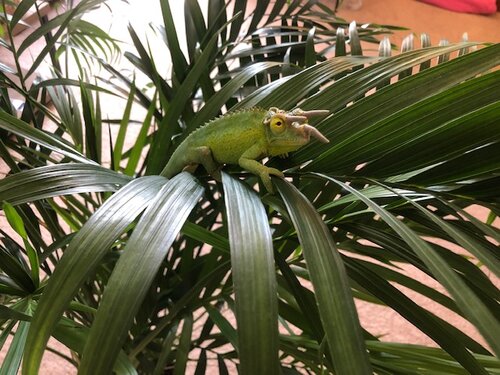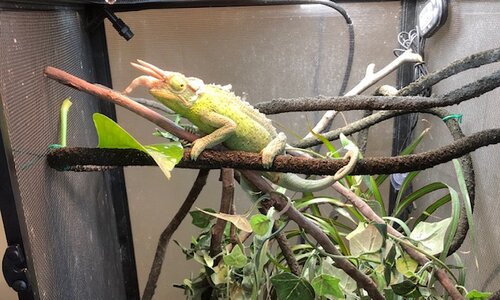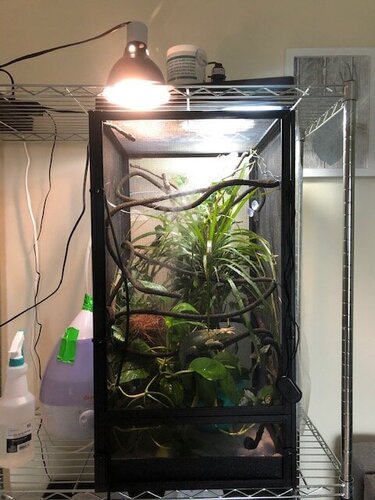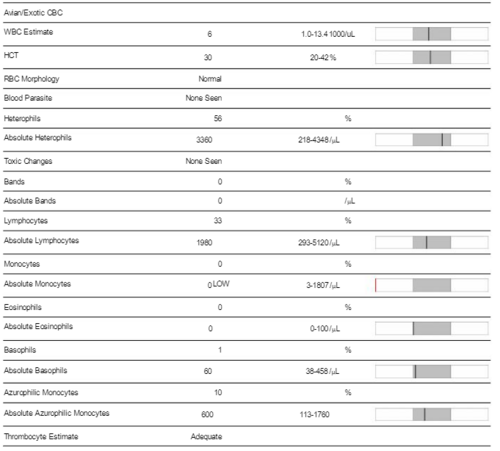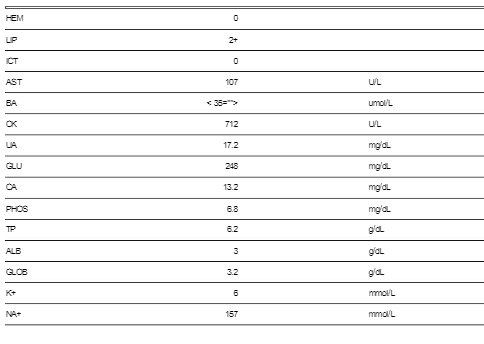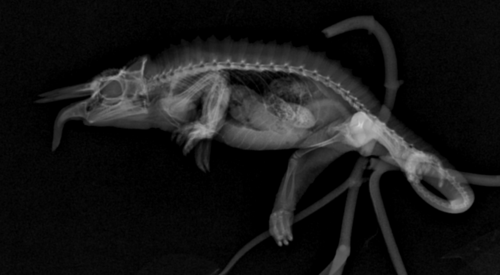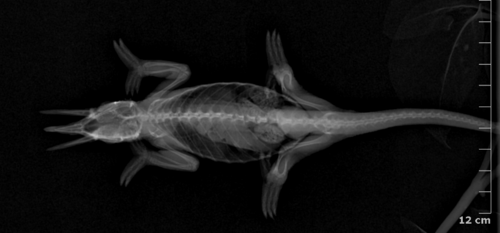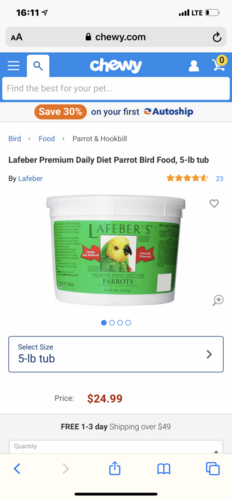Hi Everyone,
My male Jackson's had some health issues, and I'm hoping to find answers and/or confirmation on what's going on.
Since the day I got him (Early February), his rostral horn has been growing in a downward bend (I'll post pictures below). By reviewing photos over time, this growth has been a slow/ consistent progression. I reached out to the breeder and he suggested supplementing calcium w/D3 (I think in case of MBD?). The horn has always been hard and bone-like, never soft or flimsy. Up until this point he's been otherwise really healthy. I took him to my local exotic vet for a wellness check and they said he was really healthy (strong grip, typical "attitude" etc.), and only made a couple of minor suggestions to his care: because he already had a T8 UVB bulb, they said to stop supplementing with D3 (he only took this for 3 weeks or so), and to give him a bath a couple of times a week. They also recommended increasing his multivitamin to 1x per week instead of monthly.
The second issue occurred much more recently, and I'm honestly heartbroken because I feel like I tried so hard to take care of him the right way. Over the holiday weekend, he fell from the top of his cage (he was really active all day, didn't show any signs of illness/distress) and hasn't acted right since. He stopped using his back legs as much, wasn't nearly as active, turned dark green, and I observed a decrease in his appetite. I brought him to the vet ASAP last Monday, and he was diagnosed with kidney failure w/ uric acid levels ~17. They also noted in his X-ray that there might be early signs of MBD based on the appearance of his digits, but that it could be subjective based on the imaging. He stayed at the vet all last week for fluids/medical treatment. His uric acid levels came down to 13, and they sent him home with allopurinol and I've been administering this myself since then.
Chameleon Info: Husbandry has changed over time as I've learned. Initial conditions are in Blue and current/ new conditions are in Green (if changed)
Cage Info:
Current Problem - See initial description. His rostral horn was concerning to me, even though he was otherwise in good health. Has anyone seen this type of horn growth before/ what causes it? The vet said it could have been a fall that permanently affected the growth rate.
More recently, he has been suffering from kidney failure and unfortunately the prognosis is not good, as I understand chameleons typically do not recover from this. He is currently on allopurinol, enrofloxacin and metronidazole. My best understanding from what I read is that kidney failure is typically caused by dehydration. Unless this is disease manifesting from an event a long time ago, I'm not entirely sure that his humidity would have dropped to cause this any time recently. I also read that Jackson's are particularly sensitive to supplementation, so could that have been the cause?
The photo of him on the palm plant was from back in April, and the other photos are more recent (I want to show the change in shape of the horn here). I've also attached his x-rays and bloodwork.
My male Jackson's had some health issues, and I'm hoping to find answers and/or confirmation on what's going on.
Since the day I got him (Early February), his rostral horn has been growing in a downward bend (I'll post pictures below). By reviewing photos over time, this growth has been a slow/ consistent progression. I reached out to the breeder and he suggested supplementing calcium w/D3 (I think in case of MBD?). The horn has always been hard and bone-like, never soft or flimsy. Up until this point he's been otherwise really healthy. I took him to my local exotic vet for a wellness check and they said he was really healthy (strong grip, typical "attitude" etc.), and only made a couple of minor suggestions to his care: because he already had a T8 UVB bulb, they said to stop supplementing with D3 (he only took this for 3 weeks or so), and to give him a bath a couple of times a week. They also recommended increasing his multivitamin to 1x per week instead of monthly.
The second issue occurred much more recently, and I'm honestly heartbroken because I feel like I tried so hard to take care of him the right way. Over the holiday weekend, he fell from the top of his cage (he was really active all day, didn't show any signs of illness/distress) and hasn't acted right since. He stopped using his back legs as much, wasn't nearly as active, turned dark green, and I observed a decrease in his appetite. I brought him to the vet ASAP last Monday, and he was diagnosed with kidney failure w/ uric acid levels ~17. They also noted in his X-ray that there might be early signs of MBD based on the appearance of his digits, but that it could be subjective based on the imaging. He stayed at the vet all last week for fluids/medical treatment. His uric acid levels came down to 13, and they sent him home with allopurinol and I've been administering this myself since then.
Chameleon Info: Husbandry has changed over time as I've learned. Initial conditions are in Blue and current/ new conditions are in Green (if changed)
- Your Chameleon - The species, sex, and age of your chameleon. How long has it been in your care? Jackson's (male), currently approx. 1 year, 2 months old. I got him at 8 months.
- Handling - How often do you handle your chameleon? Once/weekly when he was healthy. Now daily for medications and hand-feeding
- Feeding - What are you feeding your cham? What amount? What is the schedule? How are you gut-loading your feeders? Crickets (5-8) every other day, occasional hornworm. Gut-loading was initially Fluker's, but I observed quality issues with the product. Initally after that I was using potato, oats, and orange slices. After doing a bunch of research, I switched his gutload to a home-made recipe including: dandelion leaves, sweet potato, carrots, raspberries, blueberries, orange, apple, and a small amount of fennel seed, basil, and bee pollen. Due to illness, he is syringe fed a liquid diet.
- Supplements - What brand and type of calcium and vitamin products are you dusting your feeders with and what is the schedule? PangeaCal w/o D3 3x per week (There was a short time I used cal + D3 due to horn issue). Herptivite 1x per month. PangeaCal w/o D3 3x per week. Herptivite 1x per month. Currently he is on a liquid syringe-fed diet due to his condition/ appetite. I bought Zoo Med reptivite for the future since it contains vit A instead of beta-carotene.
- Watering - What kind of watering technique do you use? How often and how long to you mist? Do you see your chameleon drinking? When I initially got him, I was told I just needed to mist a few times per day + provide a dripper. I quickly found out that Jackson's require high humidity at all times, and I made significant changes to his cage within the first week or two. Now, he has the exo-terra monsoon automatic mister which goes off for 2min/hour (max setting). He also has a cool mist humidifier to keep the humidity up, a constant dripper, and I mist an additional 3-5x per day depending on the need. He's kid of a shy drinker, but while I've had him I've observed him drinking a number of times.
- Fecal Description - Briefly note colors and consistency from recent droppings. Has this chameleon ever been tested for parasites? Solid brown fecal w/ white urate. Never tested for parasites. Since his fall and recent health issues, he has become quite constipated. While he was at the vet he was given an enema and they said that his fecal looked otherwise normal. Never tested for parasites, the vet didn't feel this was necessary.
- History - Any previous information about your cham that might be useful to others when trying to help you. CB from a breeder. peculiar rostral horn growth, otherwise appeared healthy. Up until recently, he'd appeared well-hydrated, light green in color, normal appetite and very active.
Cage Info:
- Cage Type - Describe your cage (Glass, Screen, Combo?) What are the dimensions? Repti-breeze 16x16x30. Shower curtain wrapped around 2 sides to hold in humidity. I was in the process of looking for a larger cage/ DIY cage based on his needs as an adult, but then all of his health issues came up.
- Lighting - What brand, model, and types of lighting are you using? What is your daily lighting schedule? Zilla T8 Tropical UVB, 40-60w basking bulb (depending on need based on the ambient temp of the room). I have his lights on a 12-hour timer. I learned that the zilla bulbs are poor quality, and per vet recommendations he now has the reptisun 10.0 sitting a few inches above the cage.
- Temperature - What temp range have you created (cage floor to basking spot)? Lowest overnight temp? How do you measure these temps? Zoo Med digital combo probe. 70-75F during the day, 80-85F basking. 65F at night.
- Humidity - What are your humidity levels? How are you creating and maintaining these levels? What do you use to measure humidity? So this is where I struggled initially. My apartment runs very dry in the winter, so the humidity was only about 30% on it's own, so the initial recommendation to mist a few times a day was clearly not enough. Within a couple of weeks with the modifications aforementioned, his humidity has been consistently 60-100%, varying throughout the day. Average is ~75%. This is measured with the Zoo Med digital combo probe.
- Plants - Are you using live plants? If so, what kind? Pothos, Dracaena, Ficus Benjamina that I rotate in the cage. When I have to take him out of the cage I have a 3-4ft. palm tree to put him on and it's without a doubt his favorite plant.
- Placement - Where is your cage located? Is it near any fans, air vents, or high traffic areas? At what height is the top of the cage relative to your room floor? He was in the corner of the living room on a side table. His newer setup is next to a wall on a metal rack on the other side of the room. In both locations are not notably drafty.
- Location - Where are you geographically located? New England, USA (CT).
Current Problem - See initial description. His rostral horn was concerning to me, even though he was otherwise in good health. Has anyone seen this type of horn growth before/ what causes it? The vet said it could have been a fall that permanently affected the growth rate.
More recently, he has been suffering from kidney failure and unfortunately the prognosis is not good, as I understand chameleons typically do not recover from this. He is currently on allopurinol, enrofloxacin and metronidazole. My best understanding from what I read is that kidney failure is typically caused by dehydration. Unless this is disease manifesting from an event a long time ago, I'm not entirely sure that his humidity would have dropped to cause this any time recently. I also read that Jackson's are particularly sensitive to supplementation, so could that have been the cause?
The photo of him on the palm plant was from back in April, and the other photos are more recent (I want to show the change in shape of the horn here). I've also attached his x-rays and bloodwork.

